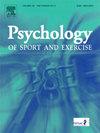FACS coding of televised darts players reveals different facial behavior before successful and unsuccessful performances
IF 3.3
2区 心理学
Q2 HOSPITALITY, LEISURE, SPORT & TOURISM
引用次数: 0
Abstract
The main objective of the present research was to use FACS on the televised pre-performance facial behavior of professional darts players to investigate if the facial behavior differed between successful and unsuccessful performances. A secondary goal of this study was to test if manual facial coding differed from automated coding using Noldus FaceReader. Therefore, a random sampling methodology was utilized to assemble video clips of the facial behavior of all players immediately before throwing darts in the 2017 World darts Championship in two performance categories, poor and good performance (10 clips per players respectively). Two FACS-certified coders blind to performance condition coded the activation intensity of 20 distinct muscle groups in the face (i.e., action units) and were compared to Noldus FaceReader output. Results showed very limited facial muscle movements in the videos across both performance categories and hardly any correlation between FACS and FaceReader data. However, multivariate data analysis of the FACS data revealed less intense action unit activity before good performance vs. poor performance. More specifically, successful darts performance was associated with lower muscle activity around the eyes and the mouth. These findings are discussed in light of previous literature suggesting that the face can be indicative of levels of arousal and anxiety and that low levels of arousal and anxiety prior to fine sensorimotor coordination are associated with performance in these situations.
电视飞镖选手的FACS编码揭示了飞镖成功和失败前不同的面部行为
本研究的主要目的是利用FACS对电视转播的专业飞镖运动员表演前的面部行为进行研究,以探讨成功和不成功的飞镖运动员的面部行为是否存在差异。本研究的第二个目的是测试手动面部编码与使用Noldus FaceReader自动编码是否不同。因此,采用随机抽样的方法,将2017年世界飞镖锦标赛中所有选手在掷飞镖前的面部行为视频片段,分为表现差和表现好两个类别(每个选手各10个片段)。两名经过facs认证的编码人员对面部20个不同肌肉群(即动作单元)的激活强度进行编码,并与Noldus FaceReader输出进行比较。结果显示,在两种表现类别的视频中,面部肌肉运动非常有限,FACS和FaceReader数据之间几乎没有任何相关性。然而,对FACS数据的多变量数据分析显示,在表现良好与表现不佳之前,动作单元的活动强度较低。更具体地说,飞镖的成功表现与眼睛和嘴巴周围较低的肌肉活动有关。这些发现是根据先前的文献进行讨论的,这些文献表明,面部可以指示唤醒和焦虑的水平,并且在精细感觉运动协调之前的低水平唤醒和焦虑与这些情况下的表现有关。
本文章由计算机程序翻译,如有差异,请以英文原文为准。
求助全文
约1分钟内获得全文
求助全文
来源期刊
CiteScore
6.40
自引率
5.90%
发文量
172
审稿时长
69 days
期刊介绍:
Psychology of Sport and Exercise is an international forum for scholarly reports in the psychology of sport and exercise, broadly defined. The journal is open to the use of diverse methodological approaches. Manuscripts that will be considered for publication will present results from high quality empirical research, systematic reviews, meta-analyses, commentaries concerning already published PSE papers or topics of general interest for PSE readers, protocol papers for trials, and reports of professional practice (which will need to demonstrate academic rigour and go beyond mere description). The CONSORT guidelines consort-statement need to be followed for protocol papers for trials; authors should present a flow diagramme and attach with their cover letter the CONSORT checklist. For meta-analysis, the PRISMA prisma-statement guidelines should be followed; authors should present a flow diagramme and attach with their cover letter the PRISMA checklist. For systematic reviews it is recommended that the PRISMA guidelines are followed, although it is not compulsory. Authors interested in submitting replications of published studies need to contact the Editors-in-Chief before they start their replication. We are not interested in manuscripts that aim to test the psychometric properties of an existing scale from English to another language, unless new validation methods are used which address previously unanswered research questions.

 求助内容:
求助内容: 应助结果提醒方式:
应助结果提醒方式:


